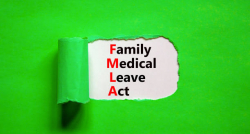FMLA and OFLA
The Federal Family and Medical Leave Act (FMLA), the Oregon Family Leave Act (OFLA) were enacted to assist the needs of employees and their families when leave is needed for qualifying reasons. FMLA and OFLA provide job and benefit protections, along with reinstatement rights. Both leave types prohibit retaliation to employees who take qualifying leave. Leave may be taken all at once or on an intermittent basis as the need requires. For more information on protected leave, see Family and Medical Leave Policy HR-12. To the extent permissible under the law, all types of protected leave (FMLA, OFLA, PLO) will run concurrently.
Eligibility
OFLA requires that an employee has worked an average of 25 hours per week in the 180 day period preceding the leave.
- During a public health emergency, employees become eligible for OFLA leave if they have worked for a covered employer for at least 30 days and have worked an average of at least 25 hours per week in the 30 days prior to taking leave.
FMLA requires that an employee has worked for 12 months, and at least 1,250 hours in the 12-month period preceding the leave.
Application for Leave
Important Note: Employees are to make application for FMLA/OFLA Protected Leave, regardless of whether or not they plan to apply for Paid Leave Oregon (PLO.) FMLA/OFLA are leave entitlements that the county is required to designate. PLO is a separate, optional paid leave benefit provided by the State of Oregon Employment Department.
When leave is foreseeable, the employee must apply for leave at least thirty (30) calendar days in advance of the leave by completing and providing to the county a Protected Leave Request Form, which is located under Supporting Documents below.
If the leave is required because of a medical emergency or other unforeseeable event, the employee must inform their supervisor ASAP, no later than three working days. The supervisor or Human Resources will determine the best way to get the Protected Leave Request Form to the employee based on the circumstances of their leave.
Qualifying Events
Events that qualify for FMLA protected leave include:
- Serious health condition of the employee's covered family member
- Pregnancy Disability (a serious health condition)
- Parental, or "baby bonding" leave
FMLA, but not OFLA leave is applied to an approved workers' compensation leave that meets the criteria of a serious health condition.
OFLA allows for additional protected leave for the following reasons:
- Sick Child Leave
- To care for a child under the age of 18 with a non-serious health condition, where the child is unable to attend school or day care.
- Bereavement Leave
- Up to two weeks of leave per death of a qualifying family member. Leave must be taken within 60 days of the date the employee learned of the family member's passing.
- Pregnancy Disability
- An eligible employee may take up to 12 weeks of pregnancy disability. Length of leave is to be substantiated by a health care provider using the Health Care Provider Certification form below under Supporting Documents.
NOTE: To the extent permissible under the law, all types of protected leave - FMLA, OFLA, PLO - will run concurrently. This may affect an employee's length of leave.
Qualifying Family Members
Under FMLA, "qualifying" family members are an employee's spouse, parent or child. In addition to the family members listed above, the following family members are also "qualifying" under OFLA:
A child’s spouse or domestic partner, a parent’s spouse or domestic partner, a sibling or stepsibling or the sibling’s or stepsibling’s spouse or domestic partner, a grandparent or the grandparent’s spouse or domestic partner, a grandchild or the grandchild’s spouse or domestic partner, a domestic partner, or any individual related by blood or affinity whose close association with a covered individual is the equivalent of a family relationship. An Affinity Relationship Form may be required to show that such a bond exists.
Serious Health Condition
A serious health condition means an illness, injury, impairment or physical or mental condition that involves:
1) Inpatient care (overnight hospital stay).
2) A critical illness or injury diagnosed as terminal, or which possesses an imminent danger of death.
3) A period of incapacity for more than three consecutive calendar days, and any subsequent treatment period of incapacity relating to the same condition, which also involves:
- Two or more treatments by a health care provider, or
- Treatment by a health care provider on at least one occasion, with a regimen of continuing treatment (e.g., prescription drugs.)
4) Permanent or long-term incapacity due to a condition for which treatment may not be effective, such as Alzheimer's disease, severe stroke, clinical depression, or terminal stages of a disease.
5) Absences for pre-natal care or pregnancy-related disability.
6) Absences for “chronic” serious health conditions
7) Absences to receive multiple treatments for restorative surgery after an accident or injury, or conditions that, if not treated, would likely result in an incapacity of more than three consecutive calendar days without medical intervention or treatment
Important Notices
Oregon Family Leave Act (OFLA) English / Spanish
Family and Medical Leave Act (FMLA) English / Spanish
Uniformed Services Employment and Reemployment Rights Act (USERRA) English / Spanish

